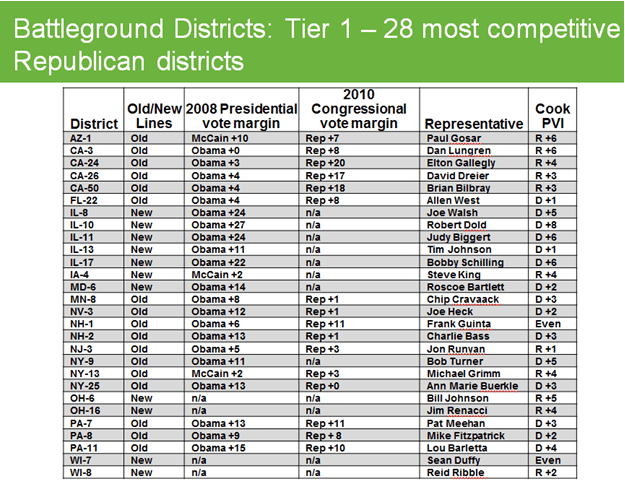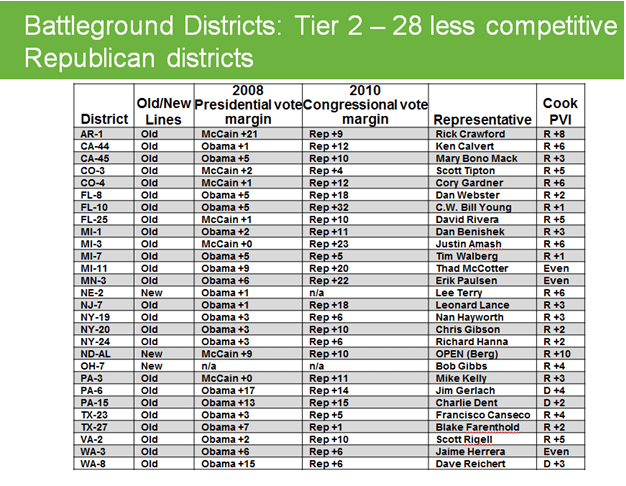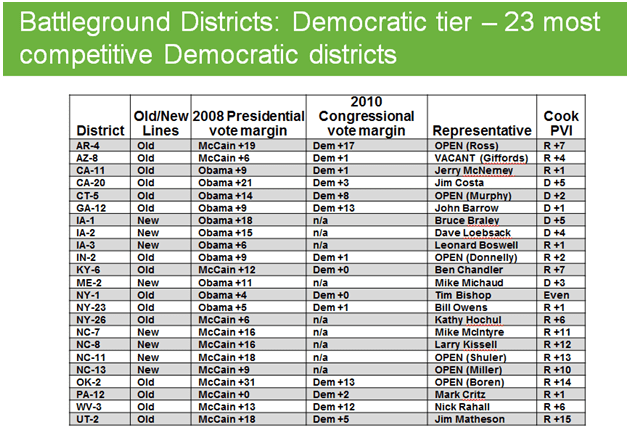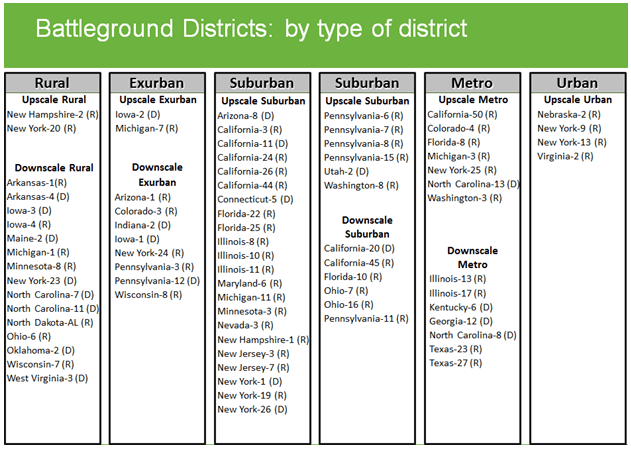Last month, virtually all House Republicans voted for Paul Ryan’s latest budget plan—(“The Path to Prosperity”)—and according to the latest battleground survey by Greenberg Quinlan Rosner for Democracy Corps and Women’s Voices. Women Vote Action Fund, they will pay the price in November.[1] In this survey of 1000 likely voters in the 56 most competitive Republican-held districts, the climate has shifted in favor of the Democrats. Voters view the Democratic Party more favorably than the Republican Party, the President is viewed far more favorably than Mitt Romney, and both the President and congressional Democrats have made gains on the ballot since last September.
Democratic incumbents in the 23 most competitive seats appear poised to do very well in their races. Democratic incumbents have hit the critical 50 percent mark on both job approval and on the ballot.
The President is not quite back to where he was in the Obama-Republican districts, but he is now more than half way back.
Just 41 percent support the Ryan budget without any description. Amazingly, after hearing information about the budget and a debate on both sides, the congressional vote flips in favor of the Democrats.
The Republicans’ vote margin in the battleground congressional districts is unchanged and still falls far short of the margins they enjoyed in November 2010. At the outset, these Republican incumbents edge their generic Democratic opponents by a 6-point margin, 49 percent to 43 percent. They lose after voters hear the debate around the Ryan budget.
In the new post-reapportionment districts where we have been able to conduct the survey, Republican job approval trails the rest of the battleground.
Several key subgroups have turned against these Republicans including unmarried women, suburban voters, senior women, and moderates.
These are districts that Republicans collectively won by an 11-point margin just a year and a half ago”—and as incumbents stake claim to unpopular positions on this newest Ryan budget, their already weakened position erodes further.
The more voters hear about the Republicans’ newest Ryan budget the more sharply they turn against the Ryan budget and these Republican incumbents. To be sure, Americans remain deeply concerned about government spending”—and Republicans do get heard when they talk about how vulnerable our debt makes the country in the long term”—but Americans are poised to punish those who would balance the budget on the backs of the poor and the middle class.
Key Findings:
• The President’s approval and vote against Romney has surged in the battleground. Obama is now tied (with a marginal 1-point advantage) with the presumptive GOP nominee. This compares favorably to the 7-point deficit he faced against Romney in these districts in December. Just 32 percent give the former governor a positive rating.
• Democrats are winning the image battle, up and down the ticket. While half of the voters in these districts register cool feelings toward the Republican Party and Republican Congress, the Democratic Party has enjoyed an 8-point bump in favorability since September 2011, and Democrats in Congress have seen a 7-point rise.
• Republican incumbents have not improved their vote position in the 33 districts where we have been tracking since March 2011– something you would expect from incumbents building support at home. In September, these incumbents were winning by a sizeable 14-point margin, 53-39. They now have just an 8-point lead, 49 to 41 percent, hovering just below the 50 percent threshold.
• Republican incumbents’ job approval rating is just 41 percent, and just 37 percent in the top tier of the most competitive 28 districts.
• Additionally, in the 14 districts we surveyed that reflect new post-redistricting lines, Republican incumbents fare worse than in the old lines. In these new districts, just a third (34 percent) say they approve of the job their Republican incumbent is doing (compared to 42 percent approval in old districts) and almost half (48 percent) say the more they hear from Republicans like their incumbent, the less they like (compared to 45 percent in the old districts).
• Voters reject the Republican position: majorities want to raise taxes on the wealthy and reject the Republican no-tax pledge.
• The Ryan budget is in trouble. Just 41 percent support it in these Republican districts with no description other than the fact that it cuts spending. When described, including using Ryan’s own language, support collapses to 34 percent.
• Many of the proposals in this newest Ryan budget are deeply unpopular, leaving Republicans vulnerable to attack, particularly on taxes, Medicaid, Medicare, cuts to anti-poverty programs, and health care.
• Republicans do well when they describe their budget as a plan to “save Medicare,” but the bulk of their proposals misinterpret voters’ enthusiasm for fiscal restraint. While the Republican plan lays out deficit reduction as an end in and of itself, voters see deficit reduction as a means to protect the programs they rely on and care about most. Any budget that eliminates these programs in order to tackle the debt has deeply misunderstood voters’ priorities.
• The result is that after voters hear a neutral description of the budget and a balanced debate between Republican arguments for the budget and Democratic attacks against it, the vote shifts a net 9 points, from a six-point vote margin for Republicans to a three-point advantage for Democrats. Importantly, those who shift include key blocs of voters that will be essential to the outcomes in these districts in November.
• Voters in these districts have polarized along gender lines, with Democrats gaining ground among women, particularly unmarried women, while Republicans pick up support among men. This movement is notable in light of the recent Republican focus on contraception.
• To be sure, Democrats still have a lot of work to do to take a majority of these seats next November. While Democrats have made important gains among some base groups such as unmarried women, they still have ground to make up among others in the Rising American Electorate, specifically young people and minority voters. While young voters are proving to be a challenge nationally, there is plenty of evidence that minority voters are consolidating. So, that could shift at some point.
• While unmarried women deliver strong margins for Democrats, they are also less enthu-siastic about turning out to vote. If these voters choose to stay at home, that could be the difference between narrow wins and narrow losses in competitive elections.[2]
Democrats gain image advantage and congressional Republicans fail to clear critical 50 percent mark
In the Republican districts we have been tracking since last March, voters are warming to the Democrats, without any appreciable gains for the Republicans – giving the Democrats a growing image advantage in these Republican districts. These incumbents continue to underperform 2010 and they are losing support with key voting blocs, including women (particularly unmarried women, independent women, and older women), white non-college-educated voters, and moderates.
Democrats are well-positioned in these competitive Democratic districts. This is not definitive because 10 are incumbents, 5 are open, and 8 are new seats. But, in those 10 Democratic seats, incumbents are now winning by 9 points, double the margin by which they won in 2010. Across all of the Democratic seats, the potential vote reaches 61 percent, 5 points above what Republi-cans have in their seats.
In addition, these Democratic incumbents have a 50 percent approval rating, 9 points above Re-publicans in their seats, who have a 41 percent approval rating in their seats.
While Democrats and the President have improved in favorability measures since September, the Republican incumbents, Republican Party, and John Boehner continue to struggle in the Republican-held districts. John Boehner’s negative rating has increased by 12 points, now at 44 percent negative. Half of all voters in these districts now give the Republican Congress and the Republican Party negative ratings. Last year at this time, just a quarter of all voters in these districts gave their Republican incumbents a negative rating; that has climbed to a third with an identical third giving their incumbents a positive rating. This is not a strong place from which to start.
And it is apparent on the ballot. In the districts we have been tracking since last March, the named Republican incumbent now holds an 8-point advantage over the unnamed Democratic challenger. This is a significant decline since September (when the Republican incumbent had a 14-point advantage) and is unchanged since December.
This shift away from Republicans has been noticeable in suburban districts where incumbents enjoyed a 10-point advantage in September. In those districts, the Republican incumbent now leads by just 4 points. The same result is also clear in all of the Republican districts surveyed here.” Democrats are now statistically tied with Republican incumbents in the suburbs. Overall, these Republicans are either losing ground or stagnating on important measures.
The vote is more polarized along gender lines, with Republicans improving among men (+8), while losing support among women (-4). Among unmarried women, Democrats have made sig-nificant improvements. In the districts we have been tracking since last March, Democrats en-joyed just a 4-point margin on Republican incumbents last December. That gap has now widened to 16 points, with the Democratic challenger leading 56 percent to 40 percent. Absent this margin, the battleground would look far different.
While Democrats have made up crucial ground with key groups since 2010, they still have a long way to go to take a majority of these seats. Among young voters however, Democrats have wit-nessed a sharp decline. Last March, Democrats had a 38-point advantage on Republican incumbents. That margin dropped to 15 points in September, down to 1 point in December, and the vote is now even (with the incumbent enjoying a 1-point advantage). Among minority voters, the Democrats’ margin has been cut in half since last March when the vote was 65-29 in favor of the Democratic challenger. The incumbent Republican now trails the Democratic challenger by just 18 points, 51 percent to 34 percent. Research elsewhere suggests there is good potential to consolidate the minority vote, which could produce later gains for the Democrats in the vote.
Obama surges in Battleground
President Obama has made significant gains among voters in these districts. His approval rating has improved significantly since the fall; in September just 39 percent said they approved of the President’s performance and a striking 56 percent disapproved. Less than 50 percent now disapprove of the President’s performance while a quarter now give the President their strong approval and his overall approval is at 46 percent. This change has been particularly pronounced among independents, among whom the President now enjoys a net approval (48 to 46 percent),” a significant difference since September when 60 percent of independent voters in these districts disapproved of the President.
This shift is reflected on the ballot. In September, Romney edged Obama by an 8-point margin, with the presumptive GOP nominee taking 50 percent of the vote. Romney’s advantage has completely eroded, with the vote now tied in these districts (with the President enjoying a marginal 1-point advantage).
Path to Prosperity?
Just 41 percent support the Ryan budget plan, described simply as “a budget for the next 10 years that cuts an additional 5.3 trillion dollars from the federal budget,” with 42 percent opposed. It is stunning that it gets only 41 percent at the outset when we only describe that it cuts money from the budget. It gets just a third of moderates, who make up more than a third of this electorate.
When the budget is described—”using as much of Paul Ryan’s description as possible (see text box below)”—support collapses to 34 percent, with just 16 percent strongly supporting the plan. The facts in the budget lose people almost immediately – dropping 7 points. Putting the spotlight on this budget is damning. A large majority of 56 percent oppose it, 44 percent strongly.

Indeed, more than half of all voters in these Republican districts say they want to vote for a candidate who will raise taxes on the wealthiest, compared to just 42 percent who say that there should be no tax increases. In the 14 new districts we surveyed, the result is even sharper”—56 percent say they want to vote for a candidate who will ask the wealthiest to pay more in taxes compared to just 36 percent who say there should be no tax increases. In other words, this budget is backwards. A debate about the budget erodes support even further. Presented with attacks on the specific cuts and Republican arguments in favor of this budget, the margin for Republican incumbents in these districts erodes from net 6-point advantage to a net 3-point deficit.

A Troubled Path to Prosperity
The Republicans’ greatest vulnerability centers on protecting the tax position of the wealthy. Almost two-thirds (64 percent) of voters said this caused them to doubt the Republican incumbent and more than a third said it raised very serious doubts. In regression analysis, this was also a strong driver of the vote, the shift in congressional vote, and which party is better on the economy. This attack raised doubts almost across the board”—including among white seniors (68 percent), white blue collar voters (66 percent), unmarried women (72 percent), independents (67 percent), and self-identified moderate voters (71 percent). This attack raises doubts even among Republican voters”—including almost half (45 percent) of Romney voters”—a potential weakness for the presumptive GOP nominee, who has supported the Ryan plan.

Republicans are also vulnerable on changes to Medicare. While this year’s budget includes an option for seniors to purchase traditional Medicare, many remain concerned about changes to Medicare’s delivery system. This raised the most serious doubts among self-identified moderate voters (76 percent), independents and weak partisans (69 percent), and voters in the rising American electorate—”unmarried women, young people, and minority voters”—of whom 69 percent said this raised serious doubts. It was also powerful among voters in rural areas (65 percent), and, critically, seniors, 68 percent of whom said this raised serious doubts. This debate does not exist in a vacuum, and we tested the arguments Republicans are making in support of their budget plan. However, the Republican counter-argument on Medicare (that this plan saves Medicare for future generations and maintains guaranteed coverage options, is signif-icantly weaker in intensity. Just over a quarter (27 percent) say the Republican argument is very convincing compared to more than a third (34 percent) who say the Democrats’ attack against Ryan’s Medicare plan raises very serious doubts.

Republicans are also vulnerable on health care. Six in ten voters are concerned about the Republican plan to allow insurance companies to deny coverage for those with pre-existing conditions, charge women higher rates than men, and eliminate the option for adult children to remain on their parents’ insurance. This attack was particularly potent for young people (three-quarters of whom said this raised serious doubts about the Republican incumbent) and for unmarried women (69 percent of whom said this raised serious doubts about the Republican incumbent). It is important to note that voters have begun to turn back on the President’s health care reform law and the Republicans’ once-strong point of attack against Obama and the Democrats has weakened considerably. Voters are now 9 points more supportive of the new health care reform law than they were in September and December. Additionally, the Republican attack against Obamacare now garners less than 50 percent support.

Nearly two-thirds (63 percent) are concerned, and a third very concerned, about Ryan plan’s proposal for Medicaid—”which would cut funding for the program almost in half (1.7 trillion dollars over the next ten years) including coverage for seniors, the disabled, and the poor. Voters most responsive to this include independents (62 percent), unmarried women (76 percent), white blue-collar voters (65 percent), voters in the Rising American Electorate (69 percent), and seniors (70 percent). This was the strongest attack among seniors, a large portion of whom rely on Medicaid funding for nursing home care. Almost six-in-ten voters (56 percent) are concerned about funding cuts for programs that benefit low-income Americans; in regression analysis this was a significant driver of the vote and of vote shifts toward Democrats. This attack is particularly potent among young women (65 percent), and minority voters (76 percent). We should note that one of the strongest attacks is focused on how these programs hurt the most vulnerable, seniors, and the poor. It is possible that there is an emerging vulnerability just as the implications of the Ryan budget become clearer.
The Republican Plan
This should not suggest that voters are not open to Republicans’ efforts to reduce the deficit. And the Republican plan contains elements that many voters like. More than two-thirds also support the Ryan plan to increase spending on veterans programs. In regression analysis, however, this argument did not have a measurable impact on the vote.
The Republicans are strongest when they frame their deficit reduction plans in the future tense ”arguing that debt and spending will leave the next generation at the mercy of China and burdened by debt and that their plan will save Medicare for future generations. This mirrors what voters consistently say worries them the most”—that future generations will inherit a has-been country that is at the mercy of China and that cannot afford to provide its citizens with the programs they value most. The key problem here is clear ”Americans support deficit reduction as a means to an end (the ability to provide Medicare and maintain a dynamic economy), not as an end in and of itself.
As a result, the Republican arguments are measurably weaker in both overall support, and crucially, in intensity. While all of the top tier attacks against the Ryan budget garnered a quarter or more intense support, only two of the Republican arguments, about veterans and energy, broke the 33 percent threshold on intensity. This is important to understanding how voters will respond to the coming debate about the budget and what it says about the nation’s priorities.
In the final vote, after hearing both Democratic attacks and Republican arguments in favor of the Ryan budget, support for Republican incumbents erodes. Critically, the biggest shifts in the vote come among key voting blocs”—including 16 percent of independents and liberal-to-moderate Republicans, those living in the South, minority voters, young people, white blue-collar voters, and unmarried women.

As this poll makes clear, the right messages could go a long way to closing this gap. Young people and minority voters shifted 13 points towards Democrats on the vote after being exposed to information about the Ryan plan and an even debate on both sides. This is not insignificant, particularly when many of the items in the budget stand to impact these voters in particular. In addition, Democrats stand to pick up moderate swing voters, independents, white non-college-educated voters, and the suburban voters (among whom Democrats have been making significant inroads over the last two years).
But Democrats need to start with a targeted and focused message”—as our regression analysis showed, while voters responded well to the Republican message about veterans, that particular message had no impact on vote choices. It might not be worth the fight. By contrast, the Democratic attack focused on middle class taxes and the contrast between Democratic priorities and those outlined in the Ryan budget is a significant driver of the vote and cuts to the heart of voters’ biggest fears about this Republican Congress and the policies it privileges.
Democracy Corps Battleground 2012
• The 2012 Democracy Corps congressional battleground research focuses intensely on the Republican-Obama districts; 44 of the 56 Republican-held districts were won by Barack Obama in 2008 but claimed by Republicans in the 2010 midterm.
• This survey also included 23 of the most competitive Democratic-held districts. This combined Republican and Democratic model, which includes the 79 most crucial battleground districts, allows Democracy Corps to track public opinion in ways that will define, shape, and structure the public debate leading up to the election in November.
• Due to redistricting and methodological limitations, the makeup of our battleground is a combination of old and new district lines, using the new district lines where states have finalized new maps and where voter lists have been updated, and using the old district lines in states that either have not finalized new maps or where updated voter lists are not yet available. This hybrid model will evolve over the course of 2012, with the increasing ability to dial in new districts with each succeeding survey. In this current survey, 22 out of the 79 districts (28 percent) reflect new district lines.
• The Republican districts are divided into 2 tiers. Tier 1 includes the 28 most competitive districts; Tier 2 is composed of 28 secondary targets. Voters in Republican districts were given a complete survey, including incumbent traits and the Ryan budget debate; respondents in Democratic districts were asked base questions, including thermometers and votes.
• 33 of the 56 Republican-held districts in this survey were included in our March 2011 battleground survey
• the first in the 2012 cycle – giving us the unique ability to track changes in public mood and opinion over time in these crucial swing districts. The trend data in this presentation represents these common districts.




[1] This memo is based on a unique survey of 1000 likely 2012 voters in 56 Republican-held battleground districts and 500 likely 2012 voters in 23 Democratic-held battleground districts conducted by Greenberg Quinlan Rosner Re-search for Democracy Corps and Women’s Voices. Women Vote Action Fund from March 29 – April 4, 2012. For questions asked in both Democratic and Republican districts, the margin of error = +/- 2.53% at 95% confidence. For questions asked just in Republican districts, the margin of error = +/- 3.1% at 95% confidence.
**Note: The time series data represents the common 33 districts originally selected in March 2011 and still in the battleground for this survey. All other data, where noted, represents either the 56 Republican-held districts, 23 Democratic-held districts, or the 79 total districts in the battleground.
[2] A separate, more detailed analysis of the contraception issue and the role of unmarried women in the battleground will be released tomorrow.




